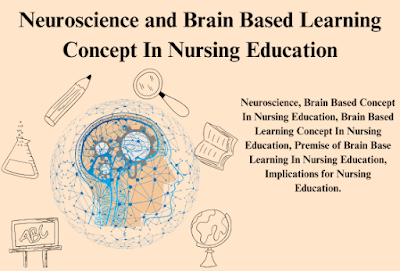The Neuroscience and Brain Based Learning Concept In Nursing Education. This approach recognizes that learning is not only about absorbing information, but also about activating the brain to promote deeper understanding, retention, and application of knowledge.
The Neuroscience and Brain Based Learning Concept In Nursing Education
Brain-based learning in nursing education, grounded in neuroscience, focuses on the brain’s natural way of learning and applies these principles to develop more effective teaching and learning strategies. The introduction of a brain-based approach can lead to a revolutionary change in nursing education and clinical practice. By incorporating brain physiology and utilizing advanced learning processes, clinical educators can specifically train nurses who are patient-centered, critically thinking, and practice-ready.
Learning Concept In Nursing Education Recent advances in neuroscience have transformed our understanding of how the brain develops and learns. Contrary to past beliefs that brain development was limited to childhood, contemporary research reveals that the brain remains adaptable throughout life—a phenomenon known as neuroplasticity (Kalia, 2008). This adaptability is observable through various direct imaging techniques, which illustrate how learning can reshape neural circuitry, enhancing both structure and function.
Brain-based learning leverages this concept by emphasizing how learning influences neural growth and synaptic connections. This approach incorporates the four primary areas of the neocortex: sensory, back-integrative, front-integrative, and motor regions (Zull, 2006). Effective learning strategies include understanding, abstract thinking, and hands-on experimentation. Repetition accelerates processing times by reinforcing neural networks, while emotional engagement strengthens brain functions, particularly in the orbitofrontal cortex, which is crucial for executive functions (Cozolino & Sprokay, 2006; Zull, 2006).
The Impact of Neuroscience on Nursing Education
Recent research has highlighted three key neuroscience-based theories relevant to nursing education: brain-based learning, deep learning, and multiple intelligences (MI). These theories provide insights into how learning strategies can be optimized for different generations of nursing students.
According to Auerbach, Buerhaus, and Staiger (2011), the population of younger registered nurses (ages 23 to 26) has been increasing since 2002. This cohort, often referred to as “digital natives” (Prensky, 2001), has grown up in an environment of constant technological engagement, including television, the internet, video games, and social media. This exposure has influenced their neuroplasticity, affecting cognitive functions such as attention span and multitasking abilities (Bradley Ruder, 2008; Prensky, 2001).
Nurse educators need to adapt their teaching methods to accommodate these young learners, who are accustomed to rapid information processing and immediate feedback. Integrating technology into the classroom, such as using internet resources or interactive group exercises, can enhance engagement and learning outcomes. Additionally, employing technologies like personal response systems can foster critical thinking and communication skills (Revell & McCurry, 2010).
Brain-Based Learning Concepts and Their Application in Nursing Education
The concept of brain-based learning emerged from interdisciplinary research in neuroscience, psychology, and biology over the past three decades. It focuses on creating optimal learning conditions for the brain (Connell, 2009; Gulpinar, 2005; Jensen, 2008). This field, also known as educational neuroscience, explores how the brain processes and retains information based on various factors, including time of day, nutrition, and stress (Jensen, 2008).
Twelve principles of brain-based learning, proposed by Caine and Caine (1991), include the continuous development of learning patterns, the essential role of emotions in learning, and the benefits of nonthreatening challenges. Emotional responses are closely linked to cognitive functions, influencing memory, decision-making, and overall engagement (Immordino-Yang & Damasio, 2007).
Practical Strategies for Implementing Brain-Based Learning in Nursing Education
To optimize brain-based learning, nursing education should incorporate strategies that enhance learning conditions:
- Relaxed Alertness: Create a high-challenge, low-threat learning environment.
- Orchestrated Immersion: Engage students in authentic, complex experiences.
- Active Processing: Encourage regular reflection and meaning-making from experiences (Caine & Caine, 1991).
These strategies help develop deeper learning pathways and offer a holistic view of how brain, body, and environment interact to influence learning.
Implications for Nursing Education
Brain-based learning can be promoted through activities that encourage knowledge construction and connections to prior knowledge. Examples include:
- Case Studies: Adaptable scenarios that evolve with new content and responses.
- Simulation Exercises: Hands-on practice that mimics real-world situations.
- Group Projects: Collaborative tasks that foster teamwork and critical thinking.
- Patient Exploration: In-depth analysis of patient cases to understand decision-making processes.
Creating a learning environment that supports interaction, authentic experiences, and balanced challenges is crucial. Faculty should design experiences that facilitate connections and address diverse learning styles and needs. Demonstrating care, enthusiasm, and organization can enhance student motivation and engagement.
Furthermore, understanding how age differences impact learning can help tailor content and teaching methods to various generational needs. Positive emotions and preparedness significantly contribute to a student’s ability to process and retain information effectively.
In conclusion, integrating neuroscience and brain-based learning concepts into nursing education can enhance teaching strategies, improve student outcomes, and better prepare future healthcare professionals for the challenges of their field.
Read More:
https://nurseseducator.com/didactic-and-dialectic-teaching-rationale-for-team-based-learning/
https://nurseseducator.com/high-fidelity-simulation-use-in-nursing-education/
First NCLEX Exam Center In Pakistan From Lahore (Mall of Lahore) to the Global Nursing
Categories of Journals: W, X, Y and Z Category Journal In Nursing Education
AI in Healthcare Content Creation: A Double-Edged Sword and Scary
Social Links:
https://www.facebook.com/nurseseducator/
https://www.instagram.com/nurseseducator/
https://www.pinterest.com/NursesEducator/
https://www.linkedin.com/in/nurseseducator/
https://www.researchgate.net/profile/Afza-Lal-Din
https://scholar.google.com/citations?hl=en&user=F0XY9vQAAAAJ

1 thought on “Neuroscience and Brain Based Learning Concept In Nursing Education”